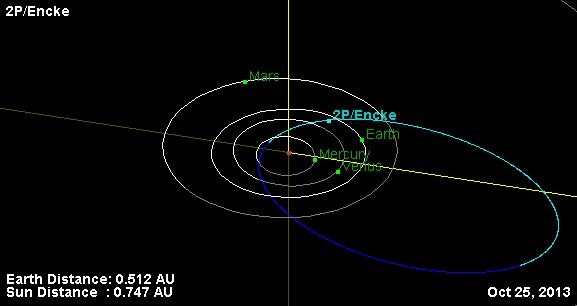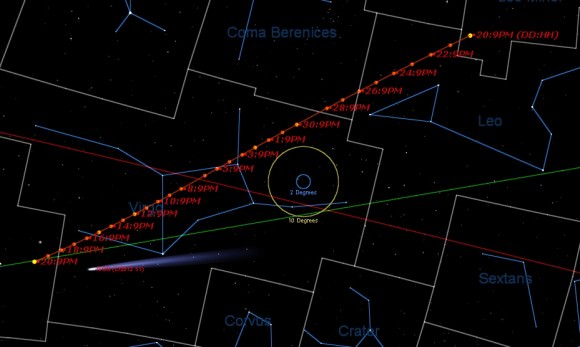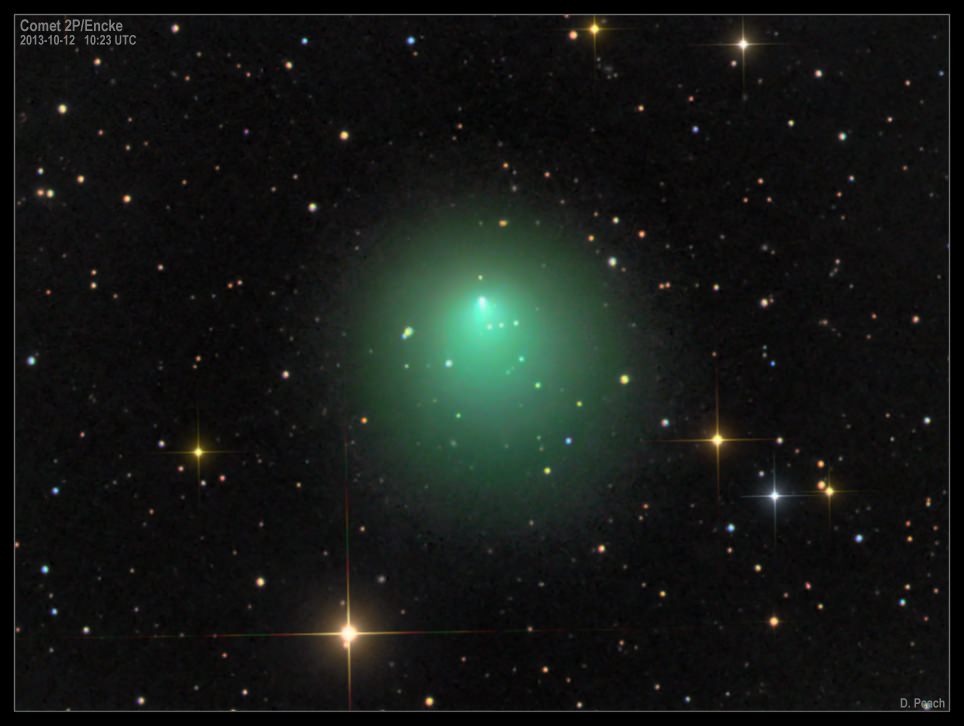2013 may well go down as “The Year of the Comet.” After over a decade punctuated by only sporadic bright comets such as 17P/Holmes, C/2011 W3 Lovejoy and C/2006 P1 McNaught, we’ve already had two naked eye comets visible this year by way of C/2012 F6 Lemmon and C/2011 L4 PanSTARRS. And of course, all eyes are on Comet C/2012 S1 ISON as it plunges towards perihelion on U.S. Thanksgiving Day, November 28th.
But there’s an “old faithful” of comets that’s currently in our solar neighborhood, and worth checking out as well. Comet 2P/Encke (pronounced EN-key) currently shines at magnitude +7.9 and is crossing from the constellation Leo Minor into Leo this week. In fact, Encke is currently 2 magnitudes— over 6 times brighter than Comet ISON —and is currently the brightest comet in our skies. Encke is expected to top out at magnitude +7 right around perihelion towards the end of November. Encke will be a fine binocular object over the next month, and once the Moon passes Last Quarter phase on October 26th we’ll once again have a good three week window for pre-dawn comet hunting. Comet Encke made its closest pass of the Earth for this orbit on October 17th at 0.48 Astronomical Units (A.U.s) distant. This month sees its closest passage to the Earth since 2003, and the comet won’t pass closer until July 11th, 2030.

This will be Comet Encke’s 62nd observed perihelion passage since its discovery by Pierre Méchain in 1786. Encke has the shortest orbit of any known periodic comet, at just 3.3 years. About every 33 years we get a favorable close pass of the comet, as last occurred in 1997, and will next occur in 2030.
But this year’s apparition of Comet Encke is especially favorable for northern hemisphere observers. This is due to its relatively high orbital inclination angle of 11.8 degrees and its passage through the morning skies from north of both the ecliptic and the celestial equator. Encke is about half an A.U. ahead of us in our orbit this month, crossing roughly perpendicular to our line of sight.
Note that Encke is also running nearly parallel to Comet ISON from our vantage point as they both make the plunge through the constellation Virgo into next month. Mark your calendars: both ISON and Encke will fit into a telescopic wide field of view around November 24th in the early dawn. Photo-op!
Here are some key dates to help you in your morning quest for Comet Encke over the next month:
-October 22nd: Crosses into the constellation Leo.
-October 24th: Passes near the +5.3 magnitude star 92 Leonis.
-October 25th: Passes near the +4.5 magnitude star 93 Leonis.
-October 27th: Passes briefly into the constellation Coma Berenices.
-October 29th: Passes near the +11th magnitude galaxy M98, and crosses into the constellation Virgo.
-October 30th: Passes near the +10th magnitude galaxy pair of M84 & M86.

-November 2nd: Passes between the two +5th magnitude stars of 31 and 32 Virginis.
-November 3rd: A hybrid solar eclipse occurs across the Atlantic and central Africa. It may just be possible to spot comet Encke with binoculars during the brief moments of totality.
-November 4th: Passes near the +3.4 magnitude star Auva (Delta Virginis).
-November 7th: Crosses from north to south over the celestial equator.
-November 11th: Passes near the +5.7th star 80 Virginis.
-November 17th: The Moon reaches Full, and enters into the morning sky.
-November 18th: Passes 0.02 A.U. (just under 3 million kilometers, or 7.8 Earth-Moon distances) from the planet Mercury. A good chance for NASA’s Messenger spacecraft to perhaps snap a pic of the comet?
-November 19th: Passes 1.5 degrees from Mercury and crosses into the constellation Libra.
-November 20th: Crosses to the south of the ecliptic plane.
-November 21st: Reaches perihelion, at 0.33 AU from the Sun.
-November 24th: Comet Encke passes just 1.25 degrees from Comet ISON. Both will have a western elongation of 15 degrees from the Sun.
-November 26th: Passes near the +4.5 magnitude star Iota Librae and the +6th magnitude star 25 Librae.
-December 1st: Crosses into the constellation Scorpius.
-December 5th: Enters into view of SOHO’s LASCO C3 camera.
Note: “Passes near” on the above list indicates a passage of Comet Encke less than one angular degree (about twice the size of a Full Moon) from an interesting object, except where noted otherwise.
Binoculars are your best bet for catching sight of Comet 2P/Encke. For middle northern latitude observers, Comet Encke reaches an elevation above 20 degrees from the horizon about two hours before local sunrise. Keep in mind, Europe and the U.K. “fall back” an hour to Standard Time this coming weekend on October 27th, and most of North America follows suit on November 3rd, pushing the morning comet vigil back an hour as well.
Two other comets are both currently brighter than ISON and also merit searching for: Comet C/2013 R1 Lovejoy, at +8.7th magnitude in Canis Minor, and Comet C/2012 X1 LINEAR, currently also in Coma Berenices and undergoing a minor outburst at magnitude +8.5.
Be sure to check these celestial wonders out as we prepare for the “Main Event” of Comet ISON in November 2013!

